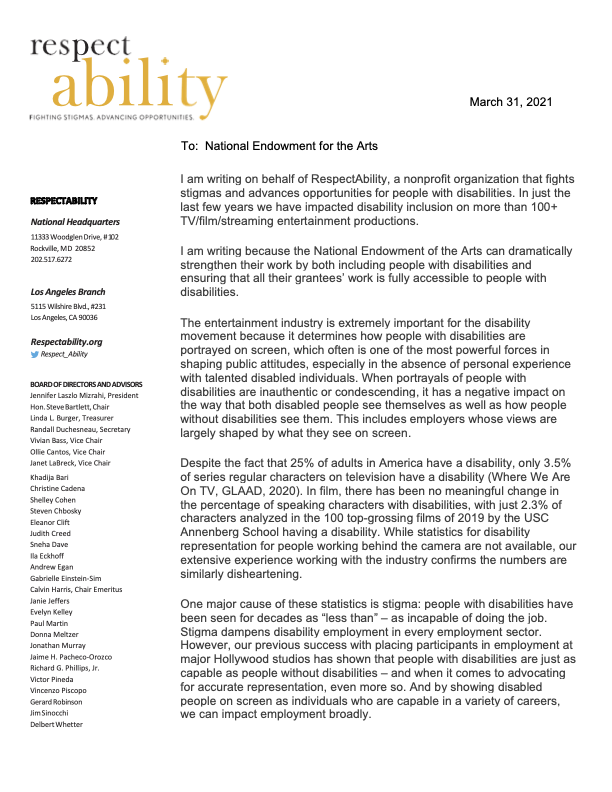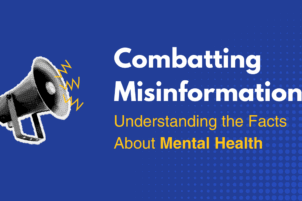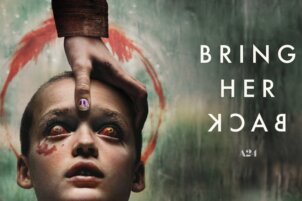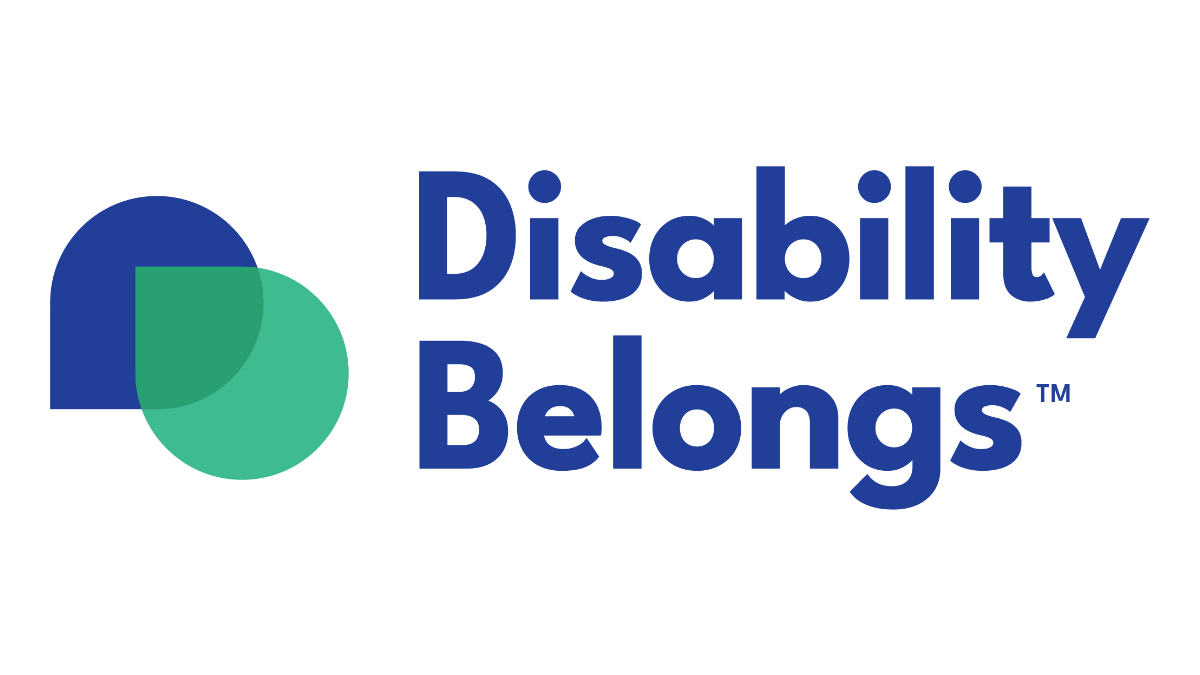RespectAbility’s testimony suggests that the NEA can dramatically strengthen their work by including more people with disabilities and ensuring that all grantees’ work is fully accessible to people with disabilities
Los Angeles, CA, April 14 – As the conversations around diversity and inclusion continue to circulate throughout the entertainment industry, RespectAbility is urging the National Endowment for the Arts (NEA) to make a bigger effort toward including more people with disabilities in their programs, as well as ensuring that all grantees’ work will be full accessible to people with disabilities.
“With a relatively small amount of additional work, the NEA could make a much larger difference in our nation on behalf of the 61 million people with disabilities,” said Lauren Appelbaum, Vice President of Communications at RespectAbility. “What we see and hear in the arts and entertainment media impacts our thoughts and feelings. Positive, accurate representation could remove stigmas that have long held people with disabilities back.”
RespectAbility’s testimony includes details on the gap in representation for people with disabilities in film and television, along with key questions that the National Endowment for the Arts could ask grantees to ensure that they are inclusive.
“We are all at our best when we are welcoming and respectful of the talents, experiences and perspectives that diversity can bring to the decision-making table. It’s time to add a disability lens to all our work so equity for people with disabilities becomes a reality,” said Appelbaum, echoing some of RespectAbility’s testimony.
The full testimony is presented below:
I am writing on behalf of RespectAbility, a nonprofit organization that fights stigmas and advances opportunities for people with disabilities. In just the last few years we have impacted disability inclusion on more than 100+ TV/film/streaming entertainment productions.
I am writing because the National Endowment of the Arts can dramatically strengthen their work by both including people with disabilities and ensuring that all their grantees’ work is fully accessible to people with disabilities.
The entertainment industry is extremely important for the disability movement because it determines how people with disabilities are portrayed on screen, which often is one of the most powerful forces in shaping public attitudes, especially in the absence of personal experience with talented disabled individuals. When portrayals of people with disabilities are inauthentic or condescending, it has a negative impact on the way that both disabled people see themselves as well as how people without disabilities see them. This includes employers whose views are largely shaped by what they see on screen.
Despite the fact that 25% of adults in America have a disability, only 3.5% of series regular characters on television have a disability (Where We Are On TV, GLAAD, 2020). In film, there has been no meaningful change in the percentage of speaking characters with disabilities, with just 2.3% of characters analyzed in the 100 top-grossing films of 2019 by the USC Annenberg School having a disability. While statistics for disability representation for people working behind the camera are not available, our extensive experience working with the industry confirms the numbers are similarly disheartening.
One major cause of these statistics is stigma: people with disabilities have been seen for decades as “less than” – as incapable of doing the job. Stigma dampens disability employment in every employment sector. However, our previous success with placing participants in employment at major Hollywood studios has shown that people with disabilities are just as capable as people without disabilities – and when it comes to advocating for accurate representation, even more so. And by showing disabled people on screen as individuals who are capable in a variety of careers, we can impact employment broadly.
The best source of accurate portrayals is authentic real-world experience, so there is a virtuous circle: increasing the number of people with disabilities working in the entertainment industry leads to more diverse and authentic representation on screen, further reducing stigma and increasing employment in all sectors. This is a prime opportunity to improve the disappointing statistics because (although the pandemic has put some productions on hold) projects are being pipelined for development. Likewise, more animation projects are being greenlit. Therefore, as writers and animators are being hired, it is important that people with disabilities are filling these roles to create this systemic change.
In the economic boom prior to COVID-19, employment in the entertainment industry grew continuously with an average annual growth rate of 1.9% per year. From 2006 to 2016, total payroll employment across all industries in Los Angeles increased by 4%, while employment in the entertainment industry outpaced regional growth, adding more than 36,130 jobs, an increase of 19.4% (Exhibit 7, “Entertainment and the Rise of Digital Media in the Los Angeles Basin,” Center for a Competitive Workforce, 2018).
As a result of the pandemic, the entertainment industry has shed nearly 300,000 jobs in California, but there are certain areas of the industry still working. According to a 2016 report by Nielsen, consumers with disabilities along with their families, friends and associates make up a trillion-dollar market segment. This economic reality, along with activism of the disability community that discourages inaccurate portrayals of disability and inauthentic casting, is leading the industry to hire more people with disabilities behind the camera to ensure the authenticity of these stories.
Below is a list of key questions that the NEA can ask their grantees. Truth be told, looking inward often is harder than posing these questions to others. Take the first step by asking these same questions of your own organization and learn more how you can make your impact more inclusive.
- Does your organization have policies and/or programs that support meaningful inclusion of people with disabilities at all levels? Are they prominent on your website and materials? Do you invite people to list any accommodations they might need (e.g., sign language interpreters or the ability to bring a service animal) on all your conference registration forms?
- Will ALL people with any kind of disability be welcomed to participate? If not, why not? If so, how do you plan to identify, reach, and welcome them?
- Do you serve people with disabilities in an inclusive way (welcoming them inside the full community), or are they forced into segregated “special needs programs” which are inherently unequal?
- Has someone who uses a wheelchair personally checked the physical accessibility of your offices and programs for people who use wheelchairs?
- Has a person who is blind and who uses adaptive computer technology checked your website and facilities for accessibility?
- Do your videos and online meetings have captions? Do you have a way to communicate with people who are deaf or use other adaptive supports?
- Do you employ individuals who have disabilities? If so, what are their jobs? Do they receive the same compensation and benefits as other employees in like positions?
- How do you educate your staff, board of directors, trustees and other key people about serving and partnering with people with disabilities?
- Has your organization considered how the language it uses may affect its ability to include and mobilize those people with disabilities whose values it shares?
- Once your organization has decided that inclusion is important, how will you know that you have achieved it?
In all that you do, remember to respect individuals with disabilities as people, not projects or people to pity. This starts with the language that we use. Do use the word disability. Avoid terms like “physically challenged,” “special” and “differently-abled,” which are patronizing. People with disabilities are protected under the Americans with Disabilities Act. People with “special needs” are not. Handicap is not an acceptable term. Respect human beings and their right to be appreciated for the strengths they have, and not be defined by their disabilities. Avoid passive, victim terms like “wheelchair-bound” and “suffers from.” People with disabilities are not “victims.” Eliminate common ableist language such as “crazy.” People with disabilities should not be described as “inspirational” or “courageous” just because they have a disability.
Person-First Language (e.g. woman with a disability) puts the emphasis on the person first; followed by a description of the disability. Identity-First Language (e.g. disabled woman) puts the emphasis on the disability. The appropriateness of the language (person-first vs. identity-first) often varies, and best practice is to ask people their language preference.
Avoid the charity and medical models of disability. The charity model says people with disabilities need to be taken care of. The medical model states disabled people must be cured. Instead, strive for the social model, which says society is what needs to be changed to be accessible for people with disabilities.
There is a need for the NEA to offer grants to train talented people with disabilities for the arts, especially for roles that can combat stigmas. Our Summer Lab for Entertainment Professionals with Disabilities is in its third year, and we have been able to place people with disabilities in roles at the Walt Disney Company, Sony Pictures Entertainment, and other major studios. This program is one with proven results that can be replicated.
The NEA can still have a huge impact on social justice, diversity and inclusion even without funding any groups that focus on those issues.
Just ask the groups you fund to live up to the high values that you know they would set for themselves if they had truly stopped to think about it. You can make a tremendous positive difference in the lives of people who have been marginalized throughout history. You can achieve this in many ways:
- Request that grantees explore ways of becoming more inclusive of people with from all background and ensure their work is fully accessible.
- Build a more inclusive environment by learning respectful language.
- Celebrate great artists with disabilities.
We are all at our best when we are welcoming and respectful of the talents, experiences and perspectives that diversity can bring to the decision-making table. People who have been historically disadvantaged—due to race, ethnicity, sexual orientation or identity, caste, gender or disability status—all comprise the larger society in which we live. Inclusion and equality mean promoting justice, impartiality and fairness within the procedures and processes of institutions and systems, as well as their distribution of resources. It’s time to add a disability lens to all our work so equality for people with ALL abilities becomes a reality.
Jennifer Laszlo Mizrahi is president of RespectAbility, a nonprofit fighting stigmas and advancing opportunities so people with disabilities can fully participate in all aspects of community.








